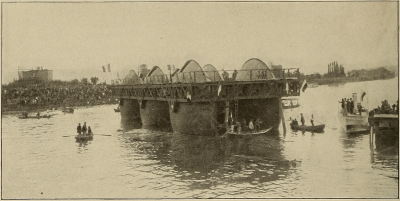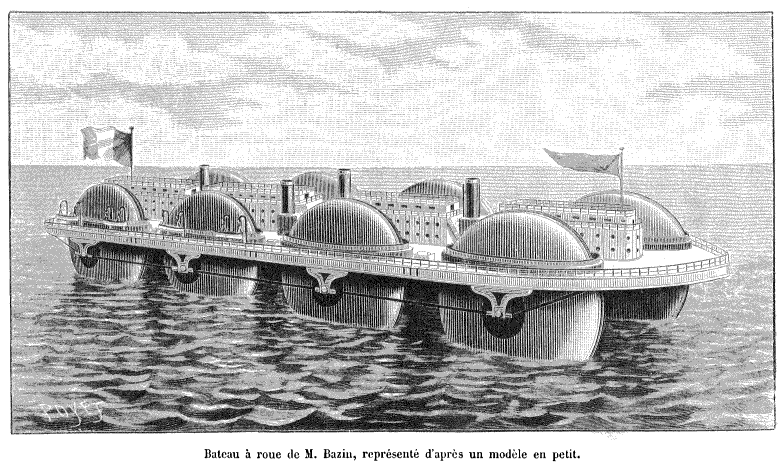Boats come in all shapes and sizes. We have container ships, oil tankers, old-timey wooden sailing ships, catamarans, trimarans, and all sorts besides. Most are designed with features that give them a certain advantage or utility that justifies their construction for a given application.
The roller ship, on the other hand, has not justified its own repeat construction. Just one example was ever built, which proved unseaworthy and impractical. Let’s explore this nautical oddity and learn about why it didn’t make waves as its inventor may have hoped.
Floater

The basic idea of the roller ship was to get much of the ship’s body out of the water. This part of the concept was sound. Contact with the water creates a great deal of drag on a ship, so reducing the amount of the boat in the water would enable it to travel much faster. Many designs, like catamarans and hydrofoils, have cut drag by reducing the wetted area of the boat, and done so effectively. The roller ship, however, didn’t do it so well.
The roller ship used a number of large rollers on either side of the boat. Each roller was disc shaped, and tapered radially, having a vaguely lens-like shape. The rollers were hollow, and intended to provide floatation for the craft and propulsion. When stationary, the discs were essentially like a skinny hull. However, the rollers could be driven akin to large wheels on a road-going craft, which provided some forward drive. The roller ship design also featured a screw drive to aid in propulsive efforts.

Just one roller ship was ever built and made operational. French inventor Ernest Bazin built a working craft in 1896, naming it after himself. Weighing in at over 200 tons It was the culminating result of five years spent testing models to explore the concept. The craft featured six large rollers, three on each side. The rollers were driven in pairs, with each axle having a 50 horsepower engine. It was a large and imposing craft, some 40 meters long and 12 meters wide, with the main hull standing 4 meters above sea level.
The general hope was that the roller ship would slash travel times by virtue of its low-drag design. Sadly, an attempt to cross the English Channel in 1897 revealed that the roller design had one unforeseen drawback. In the water, the rollers tended to drag a great deal of water up with them as they rotated. Rather than turning quickly, the rollers labored and the craft could barely break a dozen miles an hour according to a contemporary account. Even for the late 19th century, that was slow.

Bazin wasn’t deterred, and later claimed to have solved the problems of the design. Sadly, he would pass away a short time later in 1898, leaving behind unfinished plans for an eight-disc ocean liner he believed could cross from Le Havre, France to New York in just 60 hours.
Ultimately, the roller ship was a mechanically complicated concept with no real benefit. Putting rollers in water didn’t make a craft more capable than simply designing a boat with narrow fixed hulls and a more traditional propulsion system. Beyond that, the hydrofoil would prove a far more useful way of cutting drag for ships with far less fuss. There are also questions around how stable the ship could possibly be with such a high center of gravity, with much of the weight sticking so high out of the water.
And yet, like so many other fanciful designs, it captured hearts and minds along the way. It ended up depicted in all kinds of media, showing up everywhere from Nature to Scientific American. And we still remember its example today! It’s proof of how much we appreciate an oddball design, even if it has no practical value whatosever.

















I seem to remember seeing something like it in Future Life magazine.
It seems like some kind of sea train with high center of gravity.
Ah, greatness and invention in the Modernist era. Take two monolithic archetypes and combine them, boom train-boat. It’s the Liger of the seas.
Even had this been effective, I can’t imagine it would make much sense just because it would fill most of the hull with engine/drivetrains.
Good thing us humans make mistakes and learn from them.
We do?
Why would anyone even expect this to work? It was immediately obvious to me that it would not and I have only limited knowledge of hull design.
Age of tinkerer inventors mashing things up.
You still see it here.
Some things ARE just bad ideas and have been tried.
But if you say it, someone will scold you.
‘It’s never bad to try things. What kind of hacker are you?’ (para)
Imagine someone saying that about flapping.
https://www.ornithopter.org/history.manned.shtml
This is the period in which Paddlewheel was while not the only means at least the common and trusted form of mechanically powered propulsion. Weird screws and more conventional looking modern screw propeller take a long time to really take off widely – not really sure why, but they do – so while definitely a known thing at this time, it is still early days. In which case pulling double duty as a thin hull and paddlewheel I’d suggest isn’t as outlandish as it seems now.
Also worth considering this concept may have been able to fulfil a role similar to a hovercraft, something that doesn’t really exist until what 1930? 1940? maybe even not until the 50’s if you mean actually remotely practical and functional. Giving a potential niche if was developed enough to work with some ‘ships’ built that it might even have stayed in use for quite a while in some places.
It was also immediately obvious to many people that an iron-hulled ship would not float and adding a screw instead of paddle wheels would be inefficient. See what happened when Isambard Kingdom Brunel designed the SS Great Britain. TL;DR they were all wrong!
I’ll see your roller ship and raise you a roller boat!
https://www.blogto.com/city/2012/01/the_not_so_fabulous_history_of_the_roller_boat_in_toronto/
Hmm, imagine a light duty amphibious vehicle with rollers. Though really, even though it wouldn’t be smart, we might be able to find ways now to make it functional. If it could shed water better to reduce the losses of spinning the wheels, maybe with hydrophobic coatings, air or water jets, or just fairings to redirect water… If nothing else, we could make a very light small scale version – that thing was only 3.75 horsepower per ton. Maybe at smaller diameters and faster speeds, there would be enough centrifugal force to self-clear any water that leaked in. Bowls attached to bicycle-style wheels? Sounds like something colin furze would do. XD
Maybe if it could roll up on to the beach as well, so you could operate a ferry service without terminal facilities.
Something like this, but bigger? https://kaiptrade.en.made-in-china.com/product/UyNJcrkHAShW/China-Pedal-Boat-3-Big-Wheels-Water-Trike.html
What a floater indeed
Not fit for the seas,
But down in Louisiana and Florida….
Their cousin the Swamp Buggy is still rolling and floating right along
https://youtu.be/o-yWaz2vmG8?si=BZzW5-pS-v3nnCur
they just needed a better power to weight ratio
https://www.youtube.com/watch?v=sAubG28uODM
The basic idea of the roller ship was to get much of the ship’s body out of the water. This part of the concept was sound.
No it’s not.
Contact with the water creates a great deal of drag on a ship, so reducing the amount of the boat in the water would enable it to travel much faster.
Yes, that’s true, ever heard of “water displacement”. It’s the volume of water with equal weight to the ship, and it dictates how deep the ship will be in the water. If you want to reduce this, then reduce the weight of the ship. A catamaran with two hulls does not change a thing about this simple fact.
Also, those big wheels look heavy, and therefore increase water displacement significantly, and this probably offsets the advantages this system was perceived to have.
Surface area of the hull in the water is not directly related to the ships mass, the shape plays a huge part too. Yes it must displace as much water as it weighs unless it wishes to be a submarine, but the volume of of the hull below the water line (which defines the amount of water it is displacing) is very different to the surface area of that hull below the water line. According to your suggestion all boats should have spherical hulls…
In fairness the shallowest draft boats do have very flatish slightly curved hulls that start to approach that sphere profile, and a good canoe/kayak will also have that sort of dished concept in the bottom of the hull – means the sharp pointy bits are not actually very deep into the water and can more easily be lifted as you turn rapidly, really making the boat feel agile as I understand it (not an expert there).
Then you have to consider the streamlining – how much water must be pushed out of the way and by how much. Which is why multi hull boats exist – lets you have a nice large boat, with really thin hulls that don’t have to push much water out of the way. You end up with more surface area in the water than the sphere, more than a single broader hull shape in general too, but you can go much faster because you don’t have to push huge volumes of water laterally to make progress.
Or pushing too much downwards as well as laterally, since pushing water down is like climbing a swell constantly. Though pushing down in order to rise out and plane is fine.
A hulls ‘maximum speed’ is basically calculable from it’s length.
Hull shapes are complicated and still not perfected, after eons.
Length matters, cross section matters. (What your mom…) But you can’t go miles long and feet wide. Multihull edge case is as close as you can get without tipping.
A few years later he’d have learned about airfoils, and might have been first to design the hydrofoil vessel. He was just ahead of his time, and overall headed in the right direction.
I think this post misses the key idea of this design.
Drag grows with the relative speed between water and hull. By rotating the wheels that can be kept near zero, eliminating drag.
If it worked it would be huge.
maybe something the army hasn’t tried yet for a landing craft to hit the beach with.